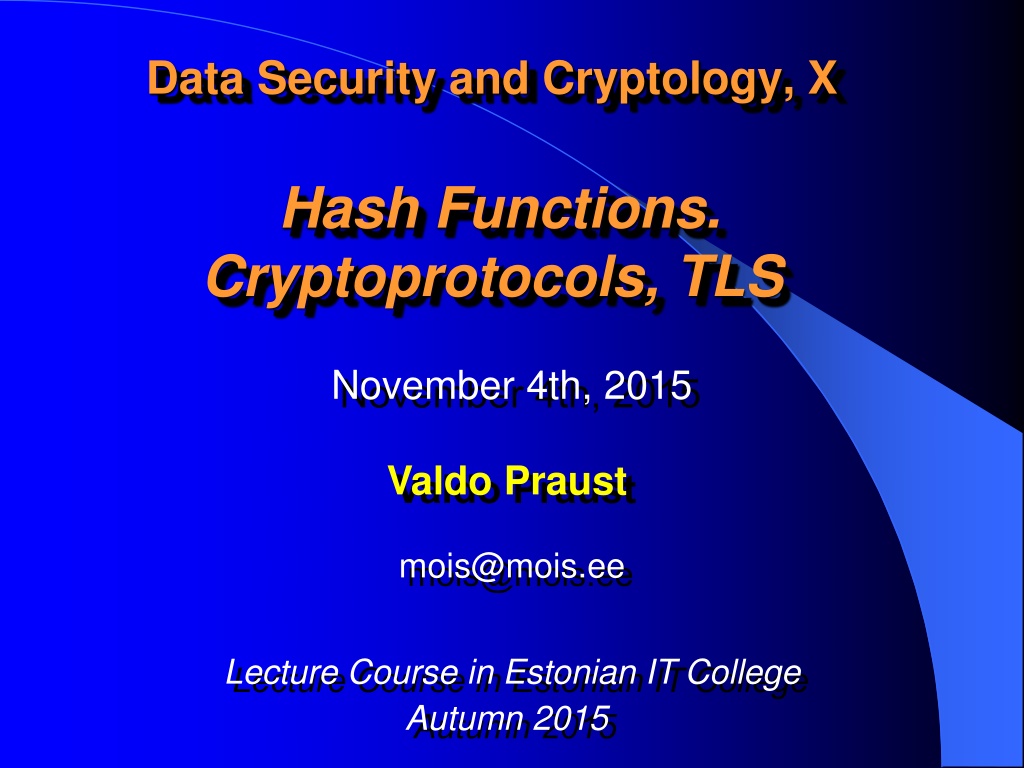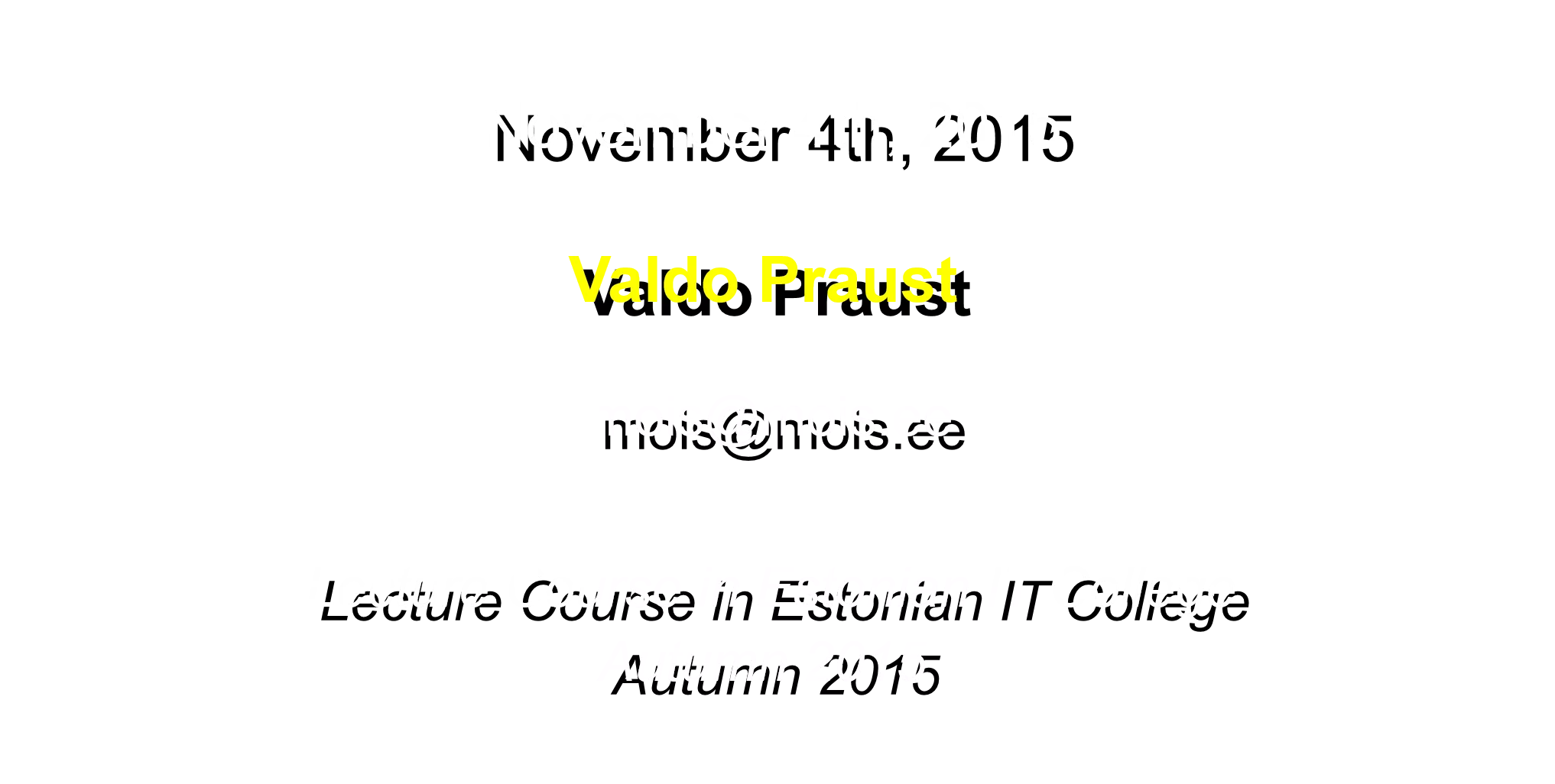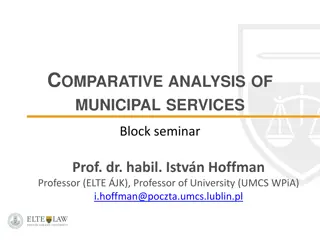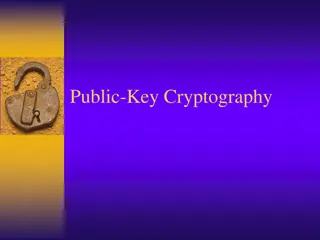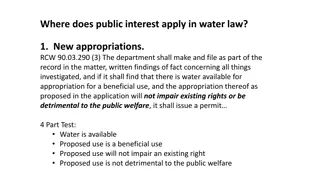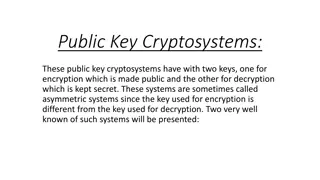Overview of Public-Key Cryptoalgorithms
Public-key cryptoalgorithms play a crucial role in modern cryptography, offering secure key exchange, digital signatures, and more. They involve the use of asymmetric keys for encryption and decryption, with RSA being a widely used algorithm due to its security features.
Download Presentation

Please find below an Image/Link to download the presentation.
The content on the website is provided AS IS for your information and personal use only. It may not be sold, licensed, or shared on other websites without obtaining consent from the author.If you encounter any issues during the download, it is possible that the publisher has removed the file from their server.
You are allowed to download the files provided on this website for personal or commercial use, subject to the condition that they are used lawfully. All files are the property of their respective owners.
The content on the website is provided AS IS for your information and personal use only. It may not be sold, licensed, or shared on other websites without obtaining consent from the author.
E N D
Presentation Transcript
Data Security and Cryptology, X Hash Functions. Cryptoprotocols, TLS November 4th, 2015 Valdo Praust mois@mois.ee Lecture Course in Estonian IT College Autumn 2015
Main Types of Cryptoalgorithms 1. Symmetric cryptoalgorithms or secret-key crypotoalgorithms are traditional (historical) cryptoalgorithms 2. Asymmetric cryptoalgorithms or public-key crypotoalgorithms are widely spread within last 25-30 years 3. Cryptographic message digests and similar constructions 4. Special-purpose algorithms for proofing, authentication etc
Public-Key Cryptoalgorithm Public-key cryptoalgorithm (avaliku v tmega kr ptoalgoritm) or asymmetric cryptoalgorithm (as mmeetriline kr ptoalgoritm) uses two keys if we encrypt by one key, we can decrypt it later by another key These keys are generated by a mathematical algrothm and are mathematically related to each other but there s impossible in practice to found from one key another
Public-Key Cryptoalgorithm: Keys Keys of public-key cryptoalgorithm are called usually public key and private key (avalik v ti ja privaatv ti) Public key is usually known for all parties (is public) Private key is usually known only by a subject or a keypair owner (people, software, server, company, chipcard etc)
Public-Key Cryptoalgorithm: Usage For a key exchanging purposes. We can transmit a symmetric cryptoalgorithm s key in an encrypted manner without any tamper- proof channel. We only need that a public key must be really public For ensuring the integrity. This is the main usage of public-key cryptoalgorithm (and even the main field of contemporary cryptography) Public-key crryptoalgorithm gives a basic idea of a digital signature (digisignatuur, digiallkiri)
Public-Key Cryptoalgorithm: Key Exchange
Public-Key Cryptoalgorithm: an Idea of Digital Signing
Most-of-Spread Public-Key Cryptoalgorithm: RSA The most-of-spread public-key cryptoalgorithm is RSA RSA is considered to be practically secure with no less than 1024-bit keylenght, for a long-time security there s preferred 2048-bit keylenght For RSA it is easy to calculate the public key from private key, but it s practically impossible (infeasible) to calculate the private key from public key Public and private key are mathematically related to each other, but finding the private key from public key needs million years or more
Specificies of RSA Was invented by Rivest, Shamir and Adleman in 1978 Security of RSA is based on a fact that factorization of a number with big factors is an infeasible (practically unsolvable) task Ensures practical security, doesn t ensure theoretical security Breaking usually needs millions of years (depending on keylenght) Is very widely spread in all around the world (most-of-spread public-key algoroithm)
RSA: Practical Details of Algorithm For finding of an appropriate e there are also some tests which ensure that it will relatively prime with (p- 1)(q-1) Greater common factor can be checked by an Euklidean algorithm Other calculations (enciphering and deciphering) is a question of realising of modular arithmetics (can be done fast both in hardware and software)
RSA: Practical Properties Enciphering and deciphering which use modular arithmtics are quite fast Despite of these fact the RSA is slower from symmertrial algroithms (AES, IDEA, Blowfish etc) some thousand times Keypair generation is much more slower from enciphering/deciphering. However, it can be realized even in software within a couple of seconds
Secure Usage of RSA RSA supports any keylenght (lenght of pq) RSA is considered to be practically secure from 1024-bit keylenght, for a long-term security from 2048-bit keylenght Most-of-used values of keylenght are (512, 768), 1024, 2048 and 4096 bits (two first of them are already practically insecure) 1024-bit key: there s a composite number of 310 decimal digits which has two 155-digit prime factors
Practical Aspects of RSA Has been for a long time patented in U.S.. Patent #4,405,829 was issued in September 20th, 1983 Patent has expired after 17 years, i.e. in 2000 Description of algorithm is public, also a couple of different software realizations (some of them with a source code) Hardware realizations are usually hundreds of times faster than software realizations
Collaboration of RSA with Symmetric Cryptoalgoriothms RSA is unsuitable for the encrytion of long plaintexts If we use RSA for a key exchange purpose, we must only encrypt the symmetric algorithm key If we use RSA for a digital signature (integrity) purposes then it was always used together with cryprographic hash algorithms. Therefore, only hash value is actually encrypted (signed) by RSA
Cryptographic Hash or Cryptographic Message Digest Cryptgraphic hash (kr ptor si) or cryptographic message digest (kr ptograafiline s numil hend) or fingerprint or thumbprint is digest with a fixed lenght which is computed from an arbitrary-length message using an one-way function One-way function ( hesuunaline funktsioon) is such a function which is easy comutable but an inverse function is unfeasible (practically uncomputable)
Cryptographic Message Digest: Usage If we have a given message-hash pair and the hash corresponds to the message then we can always sure that the hash is certainly calculated from the given message Main usage of hashes are ensuring the integrity (usually helps public-key algorithm) Practically secure hash functions find a hash which lenght is at least 160 bit (in enhanced security cases 256 bits)
Cryptographic Hash: Usage Main usage of cryptographic hashes are authentication and ensuring of integrity (for example in digital signatures) One of the main reasons of cryptographis hashes usage is that public-key cryptoalgorithm is unsuitable for processing of long plaintexts
Cryptographic Message Digest: Main Principle
Inner Structure of Cryptographic Hashes Essential part of crytpographic hashes is a compression function (tihendusfunktsioon) F, which is an one-way function and founds a fixed-lenght output from a longer fixed-lenght input. Compression function F is used in hash functions iteratively:
Mandatory Properties of Message Digest (Hash Function) Any (minor) change of message must cause a full changing of a digest Digest must be easily computable (as a typical symmetric cryptoalgorithm) Hash function must be a one-way function: for a given digest is must be infeasible to find any corresponding message which gives this digest For a pair message-digest the computing of second preimage must be infeasible (hash function must be weakly collision-free) There must be infeasible to find any such a message pairs which give the same digest (hash function must be collision-free) Compression function F must be collision-free (hash function must be pseudo-collision-free)
Birthday Paradox Birthday Paradox: a probability that for N people the birthdays of two different people coincide, will grow proportionally with N2or will grow quite fast Reason: adding of a new people will add pairs of new people from previous people For N people there are N2 N different pairs For N=23 the probability is already greated than
Inbfluence of Birthday Paradox to Hash Functions Conclusion from Birthday Paradox: if the output of hash function is N-bit long, then the probability, that K trials will give two identical hashes is K = 1,17 2N/2 The simplest cryptanalytic attack (so- called exhaustive search for hash functions) of N-bit hash function needs a considering of 2N/2different variants
Most-Of-Used Hash Functions SHA-1 was constructed in 1996 in NSA using the same principles that were earlier used in MD4 but increasing the security (using longer values). Lenght of hash is 160 bits (20 bytes) RIPEMD-160 was constructed in Belgium in early 1990s. Finds 160-bit (20-byte) hash The practically used hash functions must compute at most 160-bit hash (twice as long hash as was a minimal lenght of practically secure symmetric cryptoalgorithm, i.e. 2 x 80 bits)
Practically Unsecure Hash Functions MD2, MD4 preseccors of MD5, made by Ron Rivesti, found 128-bit hash MD5 made by Ron Rivest in 1980s. Founds 128-bit hash (digest) For these hash functions there has been found both collisions and practical breaking expoits. Despite of this fact MD5 is still unfotunately in use in numerous places
MD5: Detailed Overview Hash lenght is 128 bits (16 bytes) Was constructed by Ron Rivest in 1991 Consists of four different rounds (raund), which process the message by the 512-bit portions During each round there was taken the result of previous round and it is mixed to the next 512 bits of message
MD5: Principal Scheme
MD5: Security and Analysis 128-bit hash is too short regarding of Birthday Attack (must be at least 160 bits) In 1993 there were found collisions for a compression function (Boer, Bosselaers) In 2004 there were found collisions for a full algorithm (Wang, Feng, Lai, Yu, one hour for host computer) In 2005 there was succeeded a practical breaking of signatures based on MD5 (Lenstra, Wang, Weger) In 2006 collisions were able to construct within one minute (Klima)
MD5: Use in Emegrency Situations For an emergency situations, a temporary usage of MD5 is allowed only in the following cases: In a key strengthening mode (v tmetugevdus) hash function is used twice in a row. In makes attacking time much more longer Salting (soolamine) of passwords and keys before using a hash function some random bitstream (so- called salt) is added. It makes dictionary attacks (s nastikr nded) must more difficult to realize However, even in these cases it is not guaranteed that hash functions will be not broken at the nearest future it is recommended to use SHA-1 or RIPEMD-160
SHA-1: General Description Is structurally similar to MD5 Was constructed in 1996 by modifying the MD4 making its procedures longer and more secure Lenght of hash (digest) is 160 bits or 20 bytes Has four rounds. For each round there was taken the result of previous round and it was mixed to the next part of message using special functions
SHA-1: Security and Appliability Is much more secure than MD5 Has very widely used (about 80% of all hash functions usages in AD 2013) The Breaking Machine which costs some million euros, can calculate collision of SHA1 within thousands of years Is a part of ANSI X.90 standard Is mathematically almost identical with SHS (Secure Hash Standard), which has specified in U.S. standard FIPS PUB 180
SHA-1 Cryptanalysis Last result (MacDonald, Hawkes, Piperzyk 2009): SHA-1 collisions can be found by 251 variants, which is millions times less that by exhaustive search However, the actual collisions have not yet found If the collisions can be practically calculated, it doesn t authomatically make SHA-1 practically breakable because it needs practical invertability For enhanced security places is recommended longer and more secure versions of SHA: SHA- 256, SHA-384 or SHA-512 (common name SHA-2)
Retrospectical View: MD2 and MD4 Was construced by Ron Rivest correspondingly in 1989 and 1990 Are similar with MD5 both by the inner structure (rounds, periodical calulation) and by the hash length (128 bits) Collisions are found already in 1994-95 for both algorithms. For MD4 collisions are computable by an ordinary PC within a couple of seconds Conclusion: MD2 and MD4 are unsuitable for a practical use
RIPEMD-160: An Overview Is constructed in early 1990s by Hans Dobbertin, Antoon Bosselaers and Bart Preneel Computes a 160-bit (20-byte) hash (digest) Inner structure is quite similar with MD5 and SHA-1 (number of rounds is five, i.e. bigger) There exist some modifications of RIPEMD family: RIPEMD-128 (precessor of RIPEMD- 160e), RIPEMD-160, RIPEMD-256 and RIPEMD- 320, with a 128-, 160-, 256- and 320-bit hash correspondingly
RIPEMD: Security RIPEMD-128 isn t considered no more secure. In 1994 Paul van Oorschot and Mike Wiener offered a plan of a Breaking Machine which costed 10 millions ofeuros and which was able to break algorithm within one month Today such a machine costs less than 300 000 euros (according to Moore s rule) In 2004 there was practically found a collision of RIPEMD-128 RIPEMD-160 is considered to be secure at least next 5 years, higher versions of RIPEMD presumably much longer (10-20 years)
Enhanced Security: RIPEMD-256 and SHA-2 RIPEMD-256 is successor of RIPEMD-160 with a hash lenght of 256 bits (breaking is much more harder) SHA-2 is a family of hash functions with longer than 160-bit hash (224, 256, 384 or 512 bits) It s reasonable to use RIPEMD-256 or SHA-2 in the following two cases: for a long-term security (longer as 5-10 years) for an enhanced level of security (enhanced level of integrity)
Practical Usage of Hash Functions Are used for ensuring of integrity both with and without public-key cryptoalgorithms Are important components of digital signatures and time stamps Result: instead of ensuring of integrity of long files (messages) we can ensure integrity only of one short (160-bit or 256-bit) hash which is practically much more simple in many cases
Message Authentication Code Message authentication code, (MAC, s numi autentimiskood) is so-called hash function with a key, where both computing and verifying of a hash needs beside the message also the knowing of a certain secret key Is a necessary replacement of an hash function, when it s needed to limit the subjects who can authenticate/verify the message by the owners of a key Differs from public-key cryptoalgorithm by the fact, that the both computing and verfying processes for a MAC can be performed with the same key
Message Authentication Code Sometimes message authentication codes has its own specific algorithms. But they can easily constructed by the combining of hash algorithms and symmetric cryptoalgorithms: Some combined variants of finding the MAC:
Essence of a Cryptoprotcol Protocol (protokoll) determines, which information moves between different subjects and who/how/when transforms it Cryptoprotocol is a protocol where transformings include different cryptoalgorithms (symmetric, asymmetric, hash algorithms) and/oe key generations There are a lot of different cryptoprotocols. The most-of-spread cryptoprotocol (in Internet) is TLS (Transport Layer Security)
TLS: Main Properties and Facts Is constructed to work in Internet, i.e. in the network which bases on TCP/IP Enables to autenticate different (both) parties Enable to change the symmetric algorithm s key for secure transfer of information and to transfer information securely Includes to the higher-level protocols, adding the security to the basic functionality: ssh instead of telnet https instead of http secure ftp instead of ftp
TLS Channel TLS makes a secure channel (turvaline sidekanal) over a network which have following three properties: Channel is a private. After the parties has changed the encryption keys, all transferrable data are encrypted Channel is authenticated. It s possible both- side authentication but also a single-side authentication TLS enables to check the successful receiving of all packages (necessary property for a batch mode information transfer TCP/IP protocol)
TLS: Main Principles Under TLS connection there can be distinguished two phases: handshaking phase (autentimisfaas) message transferring phase The connection is considered to perform between two unequal parties, a client and a server It s mandatory to authenticate the server. Authentication of a client is voluntary (as it needed)
TLS Handshaking, I By a little simplified view it includes the following activities (client A starts to communicate with server B): A says Hello to B and mentions which cryptoalgorithms he/she can use A demands from B, that B proves that he is B amd sends a generated nonse to B B writes a text I am B and makes from it a hash or message digest hash( I am B + nonse) B signes hash with his/her private key sigb(hash( I am B + nonse))
TLS Handshaking, II B sends to A his public key (certificate), a text I am B and a signature sigb(hash( I am B + nonse)) A, receiving these data, verifies the signature, ensuring that his/her communication partner is realy B. A puts the public key of B to his directory Therefore, client A has authenticated server B If it s necessary, B can authenticate A by a similar way (if the both-side authentication is needed)
TLS Handshaking, III A generates a symmetric cryptoalgorithm s key (primary key) K, and puts it in his directory. A encrypts K with public key of B and sends it in encryped form to B B deciphers the primary key K with his private key and stores it into his directory Therefore, handshaking phase is ended and a corresponding symmetric algorithm key is stored by the both parties
TLS: Communication Phase Presumption: A and B start to communicate and ensure that handshaking phase has already performed earlier and the corresponding primary key K is already stored into their directories. A generates a session key S, encrypts it by a primary key K and sends the encrypted key to B B deciphers the session key S by the stored primaty key K All communication between A and B is performed by encrypted form using a session key S
